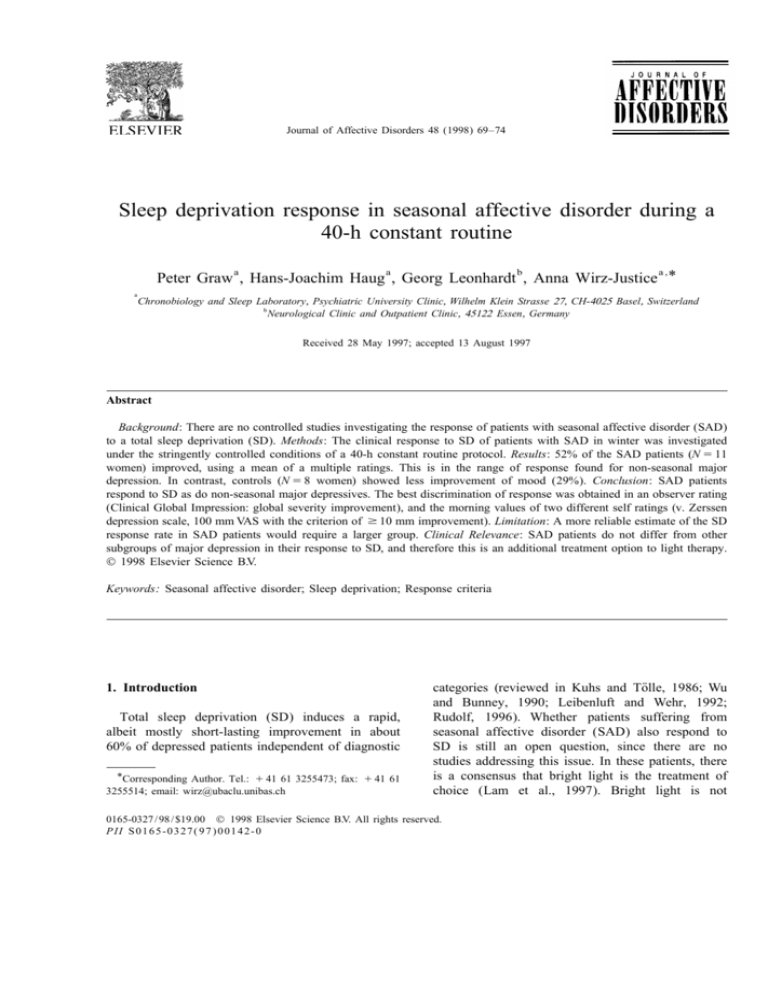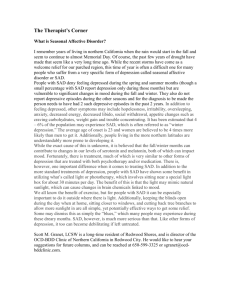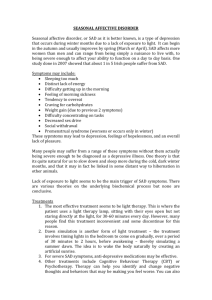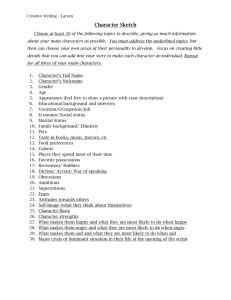
Journal of Affective Disorders 48 (1998) 69–74
Sleep deprivation response in seasonal affective disorder during a
40-h constant routine
a
a
b
a,
Peter Graw , Hans-Joachim Haug , Georg Leonhardt , Anna Wirz-Justice *
a
Chronobiology and Sleep Laboratory, Psychiatric University Clinic, Wilhelm Klein Strasse 27, CH-4025 Basel, Switzerland
b
Neurological Clinic and Outpatient Clinic, 45122 Essen, Germany
Received 28 May 1997; accepted 13 August 1997
Abstract
Background: There are no controlled studies investigating the response of patients with seasonal affective disorder (SAD)
to a total sleep deprivation (SD). Methods: The clinical response to SD of patients with SAD in winter was investigated
under the stringently controlled conditions of a 40-h constant routine protocol. Results: 52% of the SAD patients (N 5 11
women) improved, using a mean of a multiple ratings. This is in the range of response found for non-seasonal major
depression. In contrast, controls (N 5 8 women) showed less improvement of mood (29%). Conclusion: SAD patients
respond to SD as do non-seasonal major depressives. The best discrimination of response was obtained in an observer rating
(Clinical Global Impression: global severity improvement), and the morning values of two different self ratings (v. Zerssen
depression scale, 100 mm VAS with the criterion of $ 10 mm improvement). Limitation: A more reliable estimate of the SD
response rate in SAD patients would require a larger group. Clinical Relevance: SAD patients do not differ from other
subgroups of major depression in their response to SD, and therefore this is an additional treatment option to light therapy.
1998 Elsevier Science B.V.
Keywords: Seasonal affective disorder; Sleep deprivation; Response criteria
1. Introduction
Total sleep deprivation (SD) induces a rapid,
albeit mostly short-lasting improvement in about
60% of depressed patients independent of diagnostic
*Corresponding Author. Tel.: 1 41 61 3255473; fax: 1 41 61
3255514; email: wirz@ubaclu.unibas.ch
¨
categories (reviewed in Kuhs and Tolle,
1986; Wu
and Bunney, 1990; Leibenluft and Wehr, 1992;
Rudolf, 1996). Whether patients suffering from
seasonal affective disorder (SAD) also respond to
SD is still an open question, since there are no
studies addressing this issue. In these patients, there
is a consensus that bright light is the treatment of
choice (Lam et al., 1997). Bright light is not
0165-0327 / 98 / $19.00 1998 Elsevier Science B.V. All rights reserved.
PII S0165-0327( 97 )00142-0
70
P. Graw et al. / Journal of Affective Disorders 48 (1998) 69 – 74
necessary for the SD response in major depression
(Wehr et al., 1985), nor does it potentiate the SD
effect (van den Burg et al., 1990), although it
appears to prevent the relapse after recovery sleep
(Neumeister et al., 1996). There are some hints that
SAD also profit from SD (Wehr et al., 1985).
The aim of this paper is to test whether SAD
patients, as other major depressives, respond to SD.
We were able to study SD response in depressed
SAD patients whose circadian rhythms were investigated under the rigorously controlled conditions of a
constant routine (described below). Additionally, the
multiple ratings carried out permitted testing different criteria for determining clinical response.
2. Methods
The duration of the study was 4 years, each winter
half year from October to March. Women diagnosed
as suffering from SAD (DSM-III-R; American Psychiatric Association, 1987) with a depression score
$ 13 (Hamilton Rating Scale for Depression, 21 item
version HAM-D; Hamilton, 1967) and age-matched
control women who were medically screened and
had no prior psychiatric illness, participated in a
‘‘constant routine’’ protocol. The constant routine
(CR) is a design to investigate endogenous circadian
rhythms without environmental and behavioral
‘‘masking’’ (Czeisler et al., 1989). This means that
subjects are kept in a constant posture (sitting at 458
in bed), continuously awake for 40 h in a controlled
environment (temperature 228C, humidity 60%, light
, 80 lux). They receive isocaloric snacks at 2 h
intervals (details of the experimental protocol in
Brunner et al., 1996). The 40 h CR includes a night
of total SD. Since subjects remain awake throughout,
the differences from a conventional clinical SD are
the controlled wakefulness on the day before and day
after SD, lack of motor activity, and equispaced
small isocaloric meals instead of the usual 3 meals,
as well as constant environmental conditions without
time cues.
The instruments used to document clinical change
were:
• Each morning an observer rating: the Clinical
Global Impression (CGI; global severity improvement [GSI] and depression severity improvement
[DSI]; CGI, National Institute of Mental Health,
1976). In two cases where the CGI was not
documented, changes in the HAM-D without
items 4,5,6 and 18 were used.
• Every 6 h a validated self-rating scale for depression (DS / DS9; von Zerssen and Koeller, 1976).
• Half-hourly self-rating of mood on a Visual
Analogue Scale (VAS: 0 mm 5 worst possible
depressed mood, 100 mm 5 best possible mood;
Aitken, 1969), a scale which has been tested for
reliability and validity in its German version
¨
(Fahndrich
and Linden, 1982).
For the two latter measurements, the morning (11 h)
and evening ratings (20 h) were compared.
Different criteria for SD response were tested:
• an improvement of any degree (CGI, HAM-D,
DS / DS’ and VAS . 0 mm)
• an improvement of $ 10 mm (VAS)
• positive regression in a linear trend (VAS)
¨
These criteria were chosen since Haug and Fahndrich
(1986) had previously shown that the response rate
to SD in a group with major depression (N 5 76) was
40% when the criterion of VAS $ 10 mm improvement was used, and was 61% using the criterion of
any improvement at all ( . 0 mm).
For the relapse after a night of recovery sleep the
same criteria as for response were used but with the
opposite signs.
To judge a single scale, or a criterion concerning
improvement after SD, we compared the individual
scale or criterion with the mean of all scales / criteria.
A mean of all scales / criteria is usually more reliable
than a single variable and avoids extreme values.
This strategy – defined by test theory – enables us to
get the best estimation of the SD effect.
Differences between SAD patients and controls
were calculated by Chi-Square and Fisher’s Exact
Test. Linear trends were calculated by regression
analysis.
3. Results
Details of recruitment and the patient collective
have been described in a previous paper (Brunner et
Table 1
Sleep deprivation response of SAD patients
Relapse of the responders
GSI
DSI
DS
08:00
DS
20:00
VAS
11:00
$ 10 mm
VAS
20:00
$ 10 mm
VAS
11:00
. 0 mm
VAS
20:00
. 0 mm
Linear
Comp.
S 1.6
S 5.3
S 7.1
S 8.1
S 10.1
S 12.3
S 13.1
S 14.1
S 15.1
S 17.1
S 18.1
ra
b
ra
r
b
r
nr
r
nr
nr
nr
ra
b
ra
r
b
r
nr
r
nr
r
nr
r
nr
nr
r
r
r
nr
r
nr
nr
nr
r
r
r
r
nr
r
nr
nr
nr
nr
nr
r
nr
r
nr
r
nr
nr
r
nr
r
nr
r
r
nr
nr
nr
r
nr
nr
r
nr
r
r
nr
r
r
r
r
nr
r
nr
r
nr
r
r
nr
r
nr
r
r
r
r
nr
r
r
nr
r
r
nr
nr
nr
nr
nr
nr
nr
o
%
5r
56
6r
67
5r
45
5r
45
5r
45
5r
45
7r
64
8r
73
3r
27
Number
of criteria
GSI
DSI
DS
08:00
VAS
11:00
$ 10 mm
VAS
11:00
. 0 mm
9 / 9 (100%)
3 / 7 (43%)
6 / 9 (67%)
7 / 9 (78%)
3 / 7 (43%)
7 / 9 (78%)
1 / 9 (11%)
6 / 9 (67%)
2 / 9 (22%)
3 / 9 (33%)
2 / 9 (22%)
•
•
rl
•
•
nrl
–
nrl
–
–
–
•
•
rl
•
•
nrl
–
nrl
–
rl
–
rl
–
–
nrl
rl
nrl
–
nrl
–
–
–
rl
–
rl
–
rl
–
–
rl
–
rl
–
rl
–
rl
nrl
rl
nrl
–
rl
–
rl
–
49 / 95 (52%)
Mean
1rl
33
2rl
50
2rl
40
5rl
100
5rl
71
r 5 responder; nr 5 non-responder; a 5 HAM-D data; b 5 no HAM-D and CGI after SD; rl 5 relapse; nrl 5 non-relapse; – 5 non-responder; • 5 no data.
P. Graw et al. / Journal of Affective Disorders 48 (1998) 69 – 74
Sleep deprivation response in the CR
71
P. Graw et al. / Journal of Affective Disorders 48 (1998) 69 – 74
72
al., 1996). 11 SAD women (age range 27–66 y
[mean6SD: 46.5612.9 y]) and 8 control women
(24–66 y; 50.4612.5 y) completed the trial in
winter.
had sufficient subjects with mood improvement (N 5
5) to measure relapse (all did so).
3.1. SD-response in SAD ( Table 1)
For each of the single criteria there was no
significent difference between the response rate of
the SAD patients and the improvement of mood of
the controls (Chi-Square: morning DS rating x 2 5
.19; evening DS rating: x 2 5 .01; morning VAS $ 10
mm: x 2 5 1.1; evening VAS $ 10 mm: x 2 5 1.1;
morning VAS . 0 mm: x 2 5 .2; evening VAS . 0
mm: x 2 5 2.5; all Fisher’s Exact Test n.s).
However, if we compare the 7 criteria common to
both SAD and controls, patients reported an improvement of mood after SD more often than
controls (Fisher’s Exact Test, P 5 .04). Definition of
the threshold for a positive judgement was that in a
given subject, three or more of the 7 criteria must
have shown mood improvement.
The highest rate of response, 8 / 11 (73%) was
found when using a broad criterion of evening VAS
rating improvement . 0 mm, or depression severity
improvement (DSI 6 / 9, 67%). The lowest response
rate of 3 / 11 (27%) was found when using the linear
trends. If all 9 criteria were summed for each
individual, the response rate averaged 52%.
After a night of recovery sleep the relapse rate of
the responders depended on the criteria used: beween
100% (5 / 5; morning VAS rating worsening $ 10
mm) and 33% (1 / 3; GSI). The average relapse rate
over all 9 criteria was 63%.
3.3. Comparison between SAD and controls
3.2. SD-effect in controls ( Table 2)
The highest rate of mood improvement, 5 / 8
(63%), was found for the broad criterion of morning
VAS rating improvement . 0 cm. The lowest rate of
mood improvement, 1 / 8 (13%), was found for both
morning and evening ratings of VAS improvement
$ 10 mm. If all 7 criteria were summed for each
individual, the rate of mood improvement averaged
29%.
For the controls, only the criteria of VAS . 0 mm
4. Discussion
The carefully controlled conditions of the constant
routine permit very precise documentation of mood
changes over time (for the detailed time course, see
Fig. 3, Wirz-Justice, 1995). 52% of our SAD patients
improved transiently with SD. This response rate is
in the range (60%) reported in a survey of SD in
¨
major depression (Kuhs and Tolle,
1986; Wu and
Table 2
Improvement of mood after sleep deprivation of the controls
DS
08:00
DS
20:00
VAS
11:00
$ 10 mm
VAS
20:00
$ 10 mm
VAS
11:00
. 0 mm
VAS
20:00
. 0 mm
Linear
Comp.
C 3.1
C 4.1
C 5.1
C 6.1
C 7.1
C 8.1
C 11.3
C 13.1
ni
ni
i
ni
ni
ni
ni
i
i
i
ni
ni
ni
ni
ni
i
i
ni
ni
ni
ni
ni
ni
ni
i
ni
ni
ni
ni
ni
ni
ni
i
ni
i
i
i
i
ni
ni
i
ni
ni
i
ni
ni
ni
ni
i
ni
ni
ni
ni
i
ni
ni
o
%
2i
25
3i
38
1i
13
1i
13
5i
63
2i
25
2i
25
i 5 improvement; ni 5 no improvement or worsening.
Number
of criteria
6/7
1/7
2/7
2/7
1/7
2/7
0/7
2/7
(86%)
(14%)
(29%)
(29%)
(14%)
(29%)
(0%)
(29%)
16 / 56 (29%)
Mean
P. Graw et al. / Journal of Affective Disorders 48 (1998) 69 – 74
Bunney, 1990). A critical metaanalysis of the SD
response rate in relation to the year a study was
carried out indicated a decline over time: from 69%
in 1970–75 to 47% in 1986–90 (Elsenga, 1992).
Even with this critical approach, the response rate
found for SAD patients under constant routine
conditions remains in the same range as found for
non-seasonal major depression under normal clinical
conditions.
The relapse rate of 63% is somewhat below the
reported mean of 83% (Wu and Bunney, 1990).
Although the number of patients is too small to make
definitive comparisons, it is perhaps of interest to
note that the relapse rate after light treatment is also
lower in our SAD patient collective (Wirz-Justice et
al., 1989, 1993, 1996) than found in the equivalent
US studies (e.g. Rosenthal et al., 1984; Terman et al.,
1989). For a discussion of this as yet not explicable
difference, see Blehar and Lewy (1990).
In contrast, healthy controls did not improve
markedly after SD (29% with mood improvement).
Early studies reported little or no improvement of
mood in healthy controls: 4 / 23 (17%; Pflug and
¨
Tolle,
1971) and 0 / 20 (0%; Gerner et al., 1979).
Most healthy controls show a worsening of mood
after SD and an improvement is rare. The small
mood improvement in controls was reversed in all
cases after recovery sleep. That we found no significant differences between SAD and controls using
only a single criterion must be cautiously interpreted
(Type II error possible).
If we take the mean improvement using all criteria
(52%) as the most reliable and valid rating of a
response to SD, we can say that 5 of these criteria
provide a good estimate of SD response:
• improvement of global severity (in the GSI scale)
• depression self-rating scale in the morning and
evening (DS / DS9)
• Visual Analogue Scale (VAS) in the morning and
evening using the cut off improvement of $ 10
mm.
The linear trend analysis underestimates clinical
response, whereas depression severity improvement
(DSI) in the CGI scale and an improvement of any
degree in the VAS overestimate the SD effect.
Morning ratings are preferable for a good discrimina-
73
tion, since diurnal variation with worse morning
mood and evening improvement is often found to be
a predictor of SD response (Reinink et al., 1990;
Haug, 1996), and was indeed found in 6 / 11 SAD
patients.
In summary, SAD patients showed a SD response
rate similar to that reported for major depression
without seasonality. Second, as rating scales discriminating SD response we propose the following:
for the observer rating, the improvement of global
severity (CGI) and as self-rating, the depression
scale of von Zerssen and a simple 100 mm VAS
using the criterion of $ 10 mm improvement in the
morning.
Acknowledgements
This study was supported by the Swiss National
Science Foundation (Grant [ 32-28741.90). We
¨
thank K. Krauchi
for his help in statistical analysis of
the data.
References
Aitken, R.C.B., 1969. Measurement of feelings using visual
analogue scales. Proc. R. Soc. Med. 62, 17–21.
American Psychiatric Association, 1987. Diagnostic and Statistic
Manual of Mental Disorders (DSM-III-R), 3rd rev. ed.
Washington, DC.
Blehar, M.C., Lewy, A.J., 1990. Seasonal mood disorders: consensus and controversy. Psychopharmacol. Bull. 26, 465–530.
¨
Brunner, D.P., Krauchi,
K., Dijk, D.-J., Leonhardt, G., Haug, H.-J.,
Wirz-Justice, A., 1996. Sleep electroencephalogram in seasonal
affective disorder and in control women: effects of midday
light treatment and sleep deprivation. Biol. Psychiatry 40,
485–496.
Czeisler, C.A., Kronauer, R.E., Allan, J.S., Duffy, J.F., Jewett,
M.E., Brown, E.N., Ronda, J.M., 1989. Bright light induction
of strong (type 0) resetting of the human circadian pacemaker.
Science 244, 1328–1333.
Elsenga, S., 1992. Sleep Deprivation and Depression. PhD thesis,
Groningen.
¨
Fahndrich,
E., Linden, M., 1982. Reliability and validity of the
Visual Analogue Scale (VAS). Pharmacopsychiatry 15, 90–94.
Gerner, R.H., Post, R.M., Gillin, J.C., Bunney, W.E., 1979.
Biological and behavioral effects of one night’s sleep deprivation in depressed patients and normals. J. Psychiatr. Res. 15,
21–40.
Hamilton, M., 1967. Development of a rating scale for primary
depressive illness. Br. J. Soc. Clin. Psychol. 6, 278–296.
74
P. Graw et al. / Journal of Affective Disorders 48 (1998) 69 – 74
¨
Haug, H.-J., Fahndrich,
E., 1986. Problems in defining response in
therapy studies. Pharmacopsychiatry 19, 170–171.
Haug, H-J., 1996. Tagesschwankungen der Stimmung und thera¨
peutischer Schlafentzug. In: Kaspar, S., Moller,
H.-J. (Eds.),
Therapeutischer Schlafentzug. Klinik und Wirkmechanismen.
Springer, Wien, New York, pp. 165–171.
¨
Kuhs, H., Tolle,
R., 1986. Schlafentzug (Wachtherapie) als
Antidepressivum. Fortschr. Neurol. Psychiatr. 54, 341–355.
Lam, R., Terman, M., Wirz-Justice, A., 1997. Light therapy for
depressive disorders: indications and efficacy. In: Rush, J.A.
(Ed.), Modern Problems in Pharmacopsychiatry: Clinical Decision Trees in the Pharmacotherapy of Mood Disorders. Karger,
Basel, Switzerland, pp. 215–234.
Leibenluft, E., Wehr, T.A., 1992. Is sleep deprivation useful in the
treatment of depression?. Am. J. Psychiatry 149, 159–168.
National Institute of Mental Health, 1976. 028 CGI. Clinical
Global Impressions. In: Guy, W. (Ed.), ECDEU Assessment for
Psychopharmacology. Rockville, MD, pp. 217–222.
Neumeister, A., Lucht, M., Kaspar, S., 1996. Kombination von
Schlafentzug und Lichttherapie zur Behandlung depressiver
¨
¨
Storungen.
In: Kaspar, S., Moller,
H.-J. (Eds.), Therapeutischer
Schlafentzug. Klinik und Wirkmechanismen. Springer, Wien,
New York, pp. 69–80.
¨
Pflug, B., Tolle,
R., 1971. Therapie endogener Depressionen durch
Schlafentzug. Nervenarzt 42, 117–124.
Reinink, E., Bouhuys, A.L., Wirz-Justice, A., van den Hoofdakker,
R.H., 1990. Prediction of the antidepressant response to total
sleep deprivation by diurnal variation of mood. Psychiatry Res.
32, 113–123.
Rosenthal, N.E., Sack, D.A., Gillin, J.C., Lewy, A.J., Goodwin,
F.K., Davenport, Y. et al., 1984. Seasonal affective disorder: a
description of the syndrome and preliminary findings with light
therapy. Arch. Gen. Psychiatry 41, 72–80.
Rudolf, G.A.E., 1996. Klinische Effekte des therapeutischen
¨
Schlafentzugs. In: Kaspar, S., Moller,
H.-J. (Eds.), Therapeu-
tischer Schlafentzug. Klinik und Wirkmechanismen. Springer,
Wien, New York, pp. 19–32.
Terman, M., Terman, J., Quitkin, F., Stewart, J., McGrath, P.,
Nunez, et al., 1989. Dosing dimensions of light therapy:
duration and time of day. In: Thompson, C., Silverstone, T.
(Eds.), Seasonal Affective Disorder. CNS Clinical Neuroscience, London, pp. 187–204.
van den Burg, W., Bouhuys, A.L., van den Hoofdakker, R.H.,
Beersma, D.G.M., 1990. Sleep deprivation in bright and dim
light: antidepressant effects on major depressive disorder. J.
Affect. Disord. 19, 109–117.
von Zerssen, D., Koeller, D.M., 1976. Paranoid-De¨
pressivitatsskala.
Beltz Testgesellschaft, Weinheim.
Wehr, T.A., Rosenthal, N.E., Sack, D.A., Gillin, J.C., 1985.
Antidepressant effects of sleep deprivation in bright and dim
light. Acta Psychiatr. Scand. 72, 161–165.
Wirz-Justice, A., 1995. Biological rhythms in mood disorders. In:
Bloom, F.E., Kupfer, D.J. (Eds.), Psychopharmacology. The
Fourth Generation of Progress. Raven Press, New York, pp.
999–1017.
¨
Wirz-Justice, A., Graw, P., Krauchi,
K., Gisin, B., Jochum, A.,
Arendt, J., et al. 1993. Light therapy in seasonal affective
disorder is independent of time of day or circadian phase. Arch.
Gen. Psychiatry 50, 929–937.
¨
¨
Wirz-Justice, A., Graw, P., Krauchi,
K., Poldinger,
W., 1989.
Phototherapy in Switzerland: ‘‘Mehr Licht’’. In: Thompson, C.,
Silverstone, T. (Eds.), Seasonal Affective Disorder. CNS
Clinical Neuroscience, London, pp. 169–185.
¨
Wirz-Justice, A., Graw, P., Krauchi,
K., Sarrafzadeh, A., English,
J., Arendt, J. et al., 1996. ‘Natural’ light treatment of seasonal
affective disorder. J. Affect. Disord. 37, 109–120.
Wu, J.C., Bunney, W.E., 1990. The biological basis of an
antidepressant response to sleep deprivation and relapse:
review and hypothesis. Am J Psychiatry 147, 14–21.






